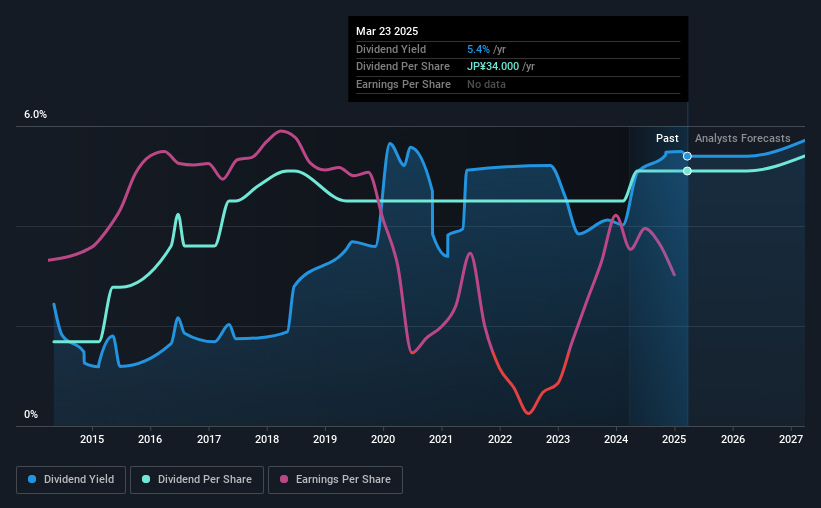- Japan
- /
- Auto Components
- /
- TSE:4246
Is It Worth Considering DaikyoNishikawa Corporation (TSE:4246) For Its Upcoming Dividend?

Readers hoping to buy DaikyoNishikawa Corporation (TSE:4246) for its dividend will need to make their move shortly, as the stock is about to trade ex-dividend. The ex-dividend date is commonly two business days before the record date, which is the cut-off date for shareholders to be present on the company's books to be eligible for a dividend payment. It is important to be aware of the ex-dividend date because any trade on the stock needs to have been settled on or before the record date. This means that investors who purchase DaikyoNishikawa's shares on or after the 28th of March will not receive the dividend, which will be paid on the 24th of June.
The company's next dividend payment will be JP¥17.00 per share, on the back of last year when the company paid a total of JP¥34.00 to shareholders. Based on the last year's worth of payments, DaikyoNishikawa stock has a trailing yield of around 5.4% on the current share price of JP¥630.00. If you buy this business for its dividend, you should have an idea of whether DaikyoNishikawa's dividend is reliable and sustainable. We need to see whether the dividend is covered by earnings and if it's growing.
Dividends are typically paid out of company income, so if a company pays out more than it earned, its dividend is usually at a higher risk of being cut. DaikyoNishikawa paid out 52% of its earnings to investors last year, a normal payout level for most businesses. Yet cash flows are even more important than profits for assessing a dividend, so we need to see if the company generated enough cash to pay its distribution. It paid out 17% of its free cash flow as dividends last year, which is conservatively low.
It's encouraging to see that the dividend is covered by both profit and cash flow. This generally suggests the dividend is sustainable, as long as earnings don't drop precipitously.
Check out our latest analysis for DaikyoNishikawa
Click here to see how much of its profit DaikyoNishikawa paid out over the last 12 months.

Have Earnings And Dividends Been Growing?
Companies with falling earnings are riskier for dividend shareholders. If earnings decline and the company is forced to cut its dividend, investors could watch the value of their investment go up in smoke. Readers will understand then, why we're concerned to see DaikyoNishikawa's earnings per share have dropped 16% a year over the past five years. When earnings per share fall, the maximum amount of dividends that can be paid also falls.
Many investors will assess a company's dividend performance by evaluating how much the dividend payments have changed over time. In the last 10 years, DaikyoNishikawa has lifted its dividend by approximately 12% a year on average. Growing the dividend payout ratio while earnings are declining can deliver nice returns for a while, but it's always worth checking for when the company can't increase the payout ratio any more - because then the music stops.
Final Takeaway
Is DaikyoNishikawa an attractive dividend stock, or better left on the shelf? The payout ratios are within a reasonable range, implying the dividend may be sustainable. Declining earnings are a serious concern, however, and could pose a threat to the dividend in future. All things considered, we are not particularly enthused about DaikyoNishikawa from a dividend perspective.
If you want to look further into DaikyoNishikawa, it's worth knowing the risks this business faces. Case in point: We've spotted 1 warning sign for DaikyoNishikawa you should be aware of.
A common investing mistake is buying the first interesting stock you see. Here you can find a full list of high-yield dividend stocks.
New: Manage All Your Stock Portfolios in One Place
We've created the ultimate portfolio companion for stock investors, and it's free.
• Connect an unlimited number of Portfolios and see your total in one currency
• Be alerted to new Warning Signs or Risks via email or mobile
• Track the Fair Value of your stocks
Have feedback on this article? Concerned about the content? Get in touch with us directly. Alternatively, email editorial-team (at) simplywallst.com.
This article by Simply Wall St is general in nature. We provide commentary based on historical data and analyst forecasts only using an unbiased methodology and our articles are not intended to be financial advice. It does not constitute a recommendation to buy or sell any stock, and does not take account of your objectives, or your financial situation. We aim to bring you long-term focused analysis driven by fundamental data. Note that our analysis may not factor in the latest price-sensitive company announcements or qualitative material. Simply Wall St has no position in any stocks mentioned.
About TSE:4246
DaikyoNishikawa
Develops, manufactures, and sells automotive, and housing and synthetic plastic parts in Japan.
Flawless balance sheet 6 star dividend payer.
Market Insights
Community Narratives





